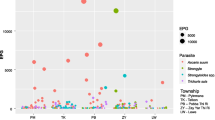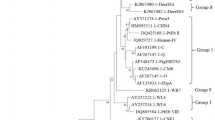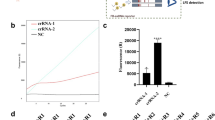Abstract
This study involved a national cross-sectional survey of gastrointestinal nematodes (GINs) of alpacas in Australia. A total of 1545 fresh faecal samples were collected from both sexes of alpacas and processed for faecal egg counts (FEC) and molecular identification of nematodes using the multiplexed tandem PCR assay. Based on egg morphology, the overall prevalence of GINs was 66% while that for strongyles was 59%. The overall mean FEC was 276 eggs per gram (EPG) of faeces, with the highest count of 17,415 EPG. Male alpacas had a higher prevalence (68%, 334/490) as well as mean FEC (328 ± 60 EPG) of GINs than females (63%, 602/954; 227 ± 26, respectively). Weaners had the highest prevalence (80%) whereas tuis had the highest FEC (402 EPG) of nematodes. The highest prevalence (77%, 293/383) and FEC (630 EPG) of GINs were observed in the summer rainfall zone followed by the Mediterranean-type rainfall, non-seasonal rainfall and winter rainfall zones. The characterisation of nematode DNA isolated from faeces revealed the occurrence of seven different GINs, including Camelostrongylus mentulatus, Cooperia spp., Haemonchus spp., Oesophagostomum spp., Ostertagia ostertagi, Teladorsagia circumcincta and Trichostrongylus spp. Besides, Nematodirus spp. and Trichuris spp. were also found during FECs. The prevalence of Haemonchus spp. was highest in the summer rainfall zone while that of C. mentulatus was highest in the Mediterranean-type rainfall, non-seasonal rainfall and winter rainfall zones. The findings of this study revealed that alpacas harbour many of the same nematodes as sheep and cattle.


Similar content being viewed by others
References
Alcaino H, Gorman T, Burgos M (1991) Helmintiasis gastrointestinal en llamas (Lama glama) de la I Región de Chile. Parasitol Día 15:93–96
Anderson N (1972) Trichostrongylid infections of sheep in a winter rainfall region. 1. Epizootiological studies in the Western District of Victoria, 1966–67. Aust J Agric Res 23:1113–1129
Anderson N (1973) Trichostrongylid infections of sheep in a winter rainfall region. 2. Epizootiological studies in the Western District of Victoria, 1967–68. Aust J Agric Res 24:599–611
Ballweber LR (2009) Ecto- and endoparasites of new world camelids. Vet Clin North Am Food Anim Prac 25:295–310
Bermudez LF (2015) Parasitosis gastrointestinal en especies zootécnicas, diagnosticadas en el laboratorio de biotecnología y microbiología animal (ESPOCH-Riobamba). Thesis. Universidad de Guayaquil, Ecuador
Beveridge I, Ford GE (1982) The trichostrongyloid parasites of sheep in South Australia and their regional distribution. Aust Vet J 59:177–179
Cafrune MM, Aguirre DH, Rickard LG (2001) First report of Lamanema chavezi (Nematoda: Trichostrongyloidea) in llamas (Lama glama) from Argentina. Vet Parasitol 97:165–168
Carmichael I (1999) Internal parasitism in alpacas in Southern Australia. In: Hack W, McGregor B, Ponzoni R, Judson G, Carmichael I, Hubbard D (eds) Australian alpaca fibre: improving productivity and marketing. Rural Industries Research and Development Corporation, pp 92–130
Carmichael I (2014) Internal parasitism in Australian alpacas. Australian Alpaca Association National Conference Adelaide. p 13–28
Cebra CK, Stang BV (2008) Comparison of methods to detect gastrointestinal parasites in llamas and alpacas. J Vet Med Assoc 232:733–741
Contreras S, Chávez V, Pinedo V, Leyva V, Suárez A (2014) Helminthiasis in alpacas (Vicugna pacos) of two peasant communities in Macusani, Puno during the dry season. Rev Investig Vet Perú 25:268–275
Craig TM (2018) Gastrointestinal nematodes, diagnosis and control. Vet Clin North Am Food Anim Prac 34:185–199
Dittmer K, Hinkson J, Dwyer C, Adlington B, van Andel M (2018) Prevalence of Candidatus Mycoplasma haemolamae, bovine viral diarrhoea virus, and gastrointestinal parasitism in a sample of adult New Zealand alpaca (Vicugna pacos). NZ Vet J 66:9–15
Edwards EE, Garner BC, Williamson LH, Storey BE, Sakamoto K (2016) Pathology of Haemonchus contortus in New World camelids in the southeastern United States: a retrospective review. J Vet Diagn Investig 28:105–109
van Erp, ML (2012) The diagnostic of gastrointestinal nematodes and coccidiosis in llamas from intensive and extensive agriculture systems in different areas of Argentina. Thesis, Utrecht University
Franz S, Wittek T, Joachim A, Hinney B, Dadak AM (2015) Llamas and alpacas in Europe: endoparasites of the digestive tract and their pharmacotherapeutic control. Vet J 204:255–262
Guerrero C, Chávez C (1967) Helmintos comunicados por primera vez en alpacas (Lama pacos) con una descripción de Spiculopteragia peruvianus n. sp. Bol Chil Parasitol 22:147–150
Harris PA, Taylor R, Thielke R, Payne J, Gonzalez N, Conde JG (2009) Research electronic data capture (REDCap)—a metadata-driven methodology and workflow process for providing translational research informatics support. J Biomed Inform 42:377–381
Hertzberg H, Kohler L (2006) Prevalence and significance of gastrointestinal helminths and protozoa in South American camelids in Switzerland. Berl Munch Tierarztl Wochenschr 119:291–294
Hill F, Death A, Wyeth T (1993) Nematode burdens of alpacas sharing grazing with sheep in New Zealand. New Zeal Vet J 41:205–208
Hinkson JA (2015) Investigations into common farm management practices and diseases on alpaca farms in New Zealand. Thesis, Massey University,
Hyuga A, Matsumoto J (2016) A survey of gastrointestinal parasites of alpacas (Vicugna pacos) raised in Japan. J Vet Med Sci 78:719–721
Jabbar A, Campbell AJD, Charles JA, Gasser RB (2013) First report of anthelmintic resistance in Haemonchus contortus in alpacas in Australia. Parasit Vectors 6:243
Leguía G (1991) The epidemiology and economic impact of llama parasites. Parasitol Today 7:54–56
Love SC (2017) Alpaca worms—an overviewDepartment of Primary Industries, NSW Government, Australia. https://www.dpi.nsw.gov.au/__data/assets/pdf_file/0004/ 318217/Alpaca-worms-an-overview.pdf. Accessed 05 May 2018
Love SC, Hutchinson GW (2003) Pathology and diagnosis of internal parasites in ruminants. In: Gross Pathology of Ruminants, Proceedings 350, Post Graduate Foundation in Veterinary Science, University of Sydney, p 309–338
Lucas JR et al (2016) Patógenos involucrados en casos fatales de diarrea en crías de alpaca de la Sierra Central del Perú. Rev Investig Vet Perú 27:169–175
Masson M, Gutiérrez G, Puicón V, Zárate D (2016) Helmintiasis y eimeriosis gastrointestinal en alpacas criadas al pastoreo en dos granjas comunales de la región Pasco, Perú, y su relación con el peso y condición corporal. Rev Investig Vet Perú 27:805–812
Mitchell S, Hopkins B, Corfield C (2016) Nematodirus lamae identified in an alpaca in the UK. Vet Rec 178:271–272
Presidente PJA (2007) Alpaca parasites and their control: recent experiences. Australian Alpaca Veterinarians Annual Conference. p 1–14
Q-Alpaca (2014) Q-Alpaca 9th annual report. Australian Alpaca Association. https://www.alpaca.asn.au. Accessed 5 July 2018
R Core Team (2017) R: a language and environment for statistical computing. R Foundation for Statistical Computing, Vienna URL https://www.R-project.org/
Rashid MH, Stevenson MA, Waenga S, Mirams G, Campbell AJ, Vaughan JL, Jabbar A (2018a) Comparison of McMaster and FECPAK G2 methods for counting nematode eggs in the faeces of alpacas. Parasit Vectors 11:278
Rashid MH, Gebrekidan H, Jabbar A (2018b) Multiplexed-tandem PCR (MT-PCR) assay to detect and differentiate gastrointestinal nematodes of alpacas. Parasit Vectors 11:370
Rashid MH, Vaughan JL, Stevenson MA, Campbell AJ, Beveridge I, Jabbar A (2018c) Anthelmintic resistance in gastrointestinal nematodes of alpacas (Vicugna pacos) in Australia. Parasit Vectors 11:388
Rashid MH, Stevenson MA, Campbell AJD, Vaughan JL, Beveridge I, Jabbar A (2019) An assessment of worm control practices used by alpaca farmers in Australia. Vet Parasitol 265:91–100
Rickard LG (1993) Parasitic gastritis in a llama (Lama glama) associated with inhibited larval Teladorsagia spp. (Nematoda: Trichostrongyloidea). Vet Parasitol 45:331–335
Robayo CIS (2015) Prevalencia de parásitos gastrointestinales en alpacas del Inga Alto, Pichincha. Thesis, Universidad San Francisco de Quito, Ecuador
Roeber F, Jex AR, Campbell AJ, Campbell BE, Anderson GA, Gasser RB (2011) Evaluation and application of a molecular method to assess the composition of strongylid nematode populations in sheep with naturally acquired infections. Infect Genet Evol 11:849–854
Roeber F, Jex AR, Gasser RB (2013a) Comparative evaluation of two DNA isolation techniques for PCR-based diagnosis of gastrointestinal nematode infections in sheep. Mol Cell Probes 27:153–157
Roeber F, Jex AR, Gasser RB (2013b) Impact of gastrointestinal parasitic nematodes of sheep, and the role of advanced molecular tools for exploring epidemiology and drug resistance-an Australian perspective. Parasit Vectors 6:153
Rosanowski S, Cogger N, Rogers C, Benschop J, Stevenson M (2012) A description of the demographic characteristics of the New Zealand non-commercial horse population with data collected using a generalised random-tessellation stratified sampling design. Prevent Vet Med 107:242–252
Saeed MA, Rashid MH, Vaughan J, Jabbar A (2018) Sarcocystosis in South American camelids: the state of play revisited. Parasit Vectors 11:146
Sprenger LK, Yoshitani UY, Buzatti A, Molento MB (2018) Occurrence of gastrointestinal parasites in wild animals in state of Paraná, Brazil. An Acad Bras Ciênc 90:231–238
Stevenson M, Nunes T, Heuer C, Marshall J, Sanchez J, Thornton R, et al. (2018) epiR tools for the analysis of epidemiological data. Melbourne, Australia: Faculty of Veterinary and Agricultural Sciences, The University of Melbourne
Tait S, Kirwan J, Fair C, Coles G, Stafford K (2002) Parasites and their control in South American camelids in the United Kingdom. Vet Rec 150:637–638
Valenzuela G, Leiva M, Quintana I (1998) Epidemiological studies on infective larvae of gastrointestinal nematodes on pasture grazed by alpacas (Lama pacos) in Valdivia, Southern Chile. Arch Med Vet 30:79–90
Welchman DB, Parr J, Wood R, Mead A, Starnes A (2008) Alpaca and llama nematodes in Britain. Vet Rec 162:832–832
Windsor RS, Windsor RH, Teran M (1992) Economic benefits of controlling internal and external parasites in South American camelids. Ann N Y Acad Sci 653:398–405
Wolf D (2010) Untersuchungen zur seroprävalenz von zystenbildenden Kokzidien und gastrointestinalparasitosen bei neuweltkameliden in Peru. Thesis, Universität Giessen
Acknowledgments
We are grateful to alpaca farmers across Australia who provided faecal samples for this study. M.H.R. is a grateful recipient of the Australian Postgraduate Award through the University of Melbourne and the PhD top-up scholarship from the AgriFutures Australia.
Funding
The financial assistance for this project was provided by the AgriFutures Australia and the Australian Alpaca Association.
Author information
Authors and Affiliations
Corresponding author
Ethics declarations
Competing interests
The authors declare that they have no competing interests.
Ethics approval
The questionnaire was approved by the Human Ethics Committee (Ethics ID 1443529) of the University of Melbourne. The participants of the survey were registered members of the Australian Alpaca Association (AAA), and their participation in the study was entirely voluntary. All active members of the AAA received an invitation through email from the head office of the AAA to participate in the survey. The use of alpacas in this study was approved by the Animal Ethics Committee (AEC no. 1413412.1) of the University of Melbourne. A plain language statement about the project was provided to participating alpaca farmers before obtaining their written consent.
Additional information
Responsible Editor: Dante Zarlenga
Publisher’s note
Springer Nature remains neutral with regard to jurisdictional claims in published maps and institutional affiliations.
Publisher’s note
Springer Nature remains neutral with regard to jurisdictional claims in published maps and institutional affiliations.
Rights and permissions
About this article
Cite this article
Rashid, M.H., Vaughan, J.L., Stevenson, M.A. et al. Epidemiology of gastrointestinal nematodes of alpacas in Australia: I. A cross-sectional study. Parasitol Res 118, 891–900 (2019). https://doi.org/10.1007/s00436-019-06235-8
Received:
Accepted:
Published:
Issue Date:
DOI: https://doi.org/10.1007/s00436-019-06235-8




